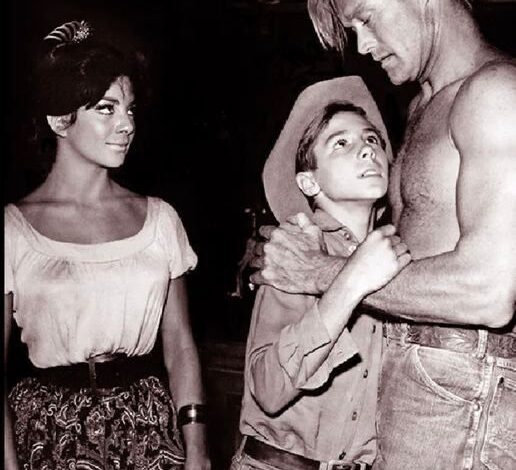Little-known mistakes and bloopers in The Rifleman!

More than sixty years after its debut, The Rifleman continues to hold a cherished place in the history of American television. Premiering in 1958, the series starred Chuck Connors as rancher Lucas McCain and Johnny Crawford as his young son, Mark. At first glance, it seemed like another entry in the wildly popular Western genre that dominated the small screen in the 1950s and 1960s. However, what set The Rifleman apart—and what has kept it beloved for generations—was its emotional core: the heartfelt and sometimes complex relationship between a father and his son.
Lucas McCain was more than just a skilled sharpshooter. As a widowed father raising his boy in the rugged New Mexico territory of the 1880s, his journey was about more than surviving gunfights. Each episode offered lessons in morality, respect, and personal strength. While the action and frontier justice drew viewers in, the deeper appeal came from Lucas’s dedication to raising Mark into a kind, courageous, and honorable young man. His struggles, doubts, and occasional mistakes made him relatable to audiences, proving that true strength comes not only from wielding a rifle but from guiding a child through life’s challenges.
The series redefined what a Western could be. Traditionally, the genre focused on shootouts and black-and-white justice, but The Rifleman introduced layers of warmth and humanity. Families watching together saw more than lawmen and outlaws—they witnessed the story of a father doing his best and a son learning to grow up with integrity. This emotional depth gave the series a universal appeal, transcending the trappings of its setting.
Like many shows of its era, The Rifleman wasn’t without quirks and production errors. One of the most well-known bloopers involves Lucas McCain’s wardrobe. In several episodes, he is seen wearing Wrangler jeans—a brand that didn’t exist in the 1880s. Such anachronisms were common in mid-century television, when producers prioritized practical filming needs over strict historical accuracy. Modern viewers with high-definition screens may easily spot these details, but they do little to diminish the show’s timeless storytelling.
Behind the scenes, there were also touching personal moments. Chuck Connors’ real-life son, Jeff Connors, made a cameo appearance in one episode. Though brief, this appearance added a layer of authenticity to a series centered around the bond between a father and son. For fans who later learned this detail, it became a treasured piece of trivia that deepened their connection to the show.
The Winchester rifle wielded by Lucas McCain became as iconic as the character himself. Modified for rapid-fire action, it allowed Lucas to fire with remarkable speed, making him a formidable figure in confrontations. Few viewers knew that this very rifle had a Hollywood history of its own—it had previously been used by legendary Western star John Wayne. This connection tied The Rifleman to a broader legacy of cinematic storytelling and solidified the weapon as a symbol of the genre.
The series also benefited from its memorable guest stars. Over its five-season run, it welcomed appearances from well-known figures who might have seemed unlikely for a Western. Baseball great Duke Snider made a special cameo, while entertainer Sammy Davis Jr. took on a groundbreaking role that challenged racial stereotypes of the time. By presenting him as an equal rather than a caricature, the show subtly pushed cultural boundaries while entertaining audiences.
One of the reasons the series has endured is its balance of action and meaning. Each week featured dramatic showdowns with rustlers, outlaws, and rival ranchers, but beneath the tension was a reminder that love and moral courage mattered most. Lucas wasn’t simply fighting to survive; he was striving to teach Mark the difference between right and wrong, even when choices were painful or complex. Mark’s innocence often served as a counterpoint to the harsh realities of frontier life, emphasizing that the greatest battles were fought with character, not bullets.
When The Rifleman aired, America itself was undergoing profound social changes. Families were navigating a rapidly modernizing world while holding on to traditional values. Lucas McCain’s character resonated deeply because he embodied this struggle—he faltered, learned, and persevered while always placing family and principles at the forefront. For viewers, this offered both comfort and inspiration during uncertain times.
Today, The Rifleman remains a staple of classic television. Reruns continue to captivate audiences, while streaming services and DVD collections introduce the series to younger generations. Even viewers unfamiliar with Westerns find themselves drawn to its universal themes: the enduring power of family, the importance of moral choices, and the resilience required to face life’s trials.
While critics sometimes note the show’s minor flaws or outdated production techniques, these imperfections are part of its charm. Fans remember the emotional moments more than any continuity errors—the pride in Lucas’s eyes as he guided Mark, or the faith Mark placed in his father even when circumstances grew difficult. These relationships gave the show a heart that transcends time.
More than six decades later, The Rifleman is celebrated not for its gunfights, but for its bold decision to place love, morality, and family at the center of a Western. The occasional bloopers, like Wrangler jeans or recycled props, only add to its nostalgic appeal, reminding viewers that even iconic legends were created by imperfect hands.
Ultimately, the show’s legacy lies in its storytelling. It wasn’t just about Lucas McCain’s skill with a rifle—it was about the values he instilled in his son and the lessons that still resonate with audiences today. By blending action, heart, and timeless themes, The Rifleman remains a shining example of television’s ability to entertain while inspiring generations to come.